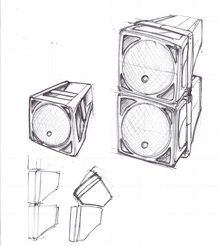

Inside Look: Mackie DLM Ultra-compact Powered Loudspeakers
Sep 19, 2012 10:32 AM
Early concept sketches and an industrial design iteration for the Mackie DLM series powered loudspeakers demonstrate the vision of a square form factor and some of the alternatives explored in the effort to combine a vertically aligned driver and 2000W of power, while reducing cabinet size by nearly a third in the case of the DLM8.
The light bulb moment that started the Mackie DLM series came at InfoComm 2009 when Mackie’s John Boudreau was making the rounds with EAW’s Jeff Rocha, looking at something new: speakers with vertically aligned drivers. The “Oh yeah” moment came two years later. This time Boudreau and Rocha were at EAW listening to the acoustically corrected tests for the DLM’s TruSource driver. They were hearing the combination of a vertical driver, 2000W of power, and EAW acoustic correction, and what that delivers in terms of clarity and presence. The end result of a difficult engineering adventure was a feeling of ease—no fighting the correction point, no fighting for power. Boudreau remembers the almost surreal experience of listening back and forth between traditional two-way speakers and the vertically aligned DLMs, and literally feeling his brain shifting to adapt to the difference. “For a moment you actually wonder if there’s a phase problem with the traditional two-way products because the difference was so dramatic,” Boudreau says.
In between light bulb and “oh yeah” moment was a lot of engineering. Boudreau says he started sketching on the plane home from InfoComm. “At that point in time, I had noticed that the speakers at the show were kind of cannon shaped, but I didn’t realize how deep those transducers were. I just knew that the high and low frequencies were aligned and imagined we could make a shorter and square-shaped box.
“When I got back and started looking up vertically aligned drivers, I quickly realized they had that double magnet lineup,” Boudreau says as his voice trails off. He gave his plane sketches to Mackie’s industrial design team anyway, and looked harder for drivers. What he found was “really heavy and deep and really expensive.”
“The dream was not that dreamy any more.”
But it was also too late to turn back. “We had kind of gotten fixated that this was something we wanted to continue to pursue,” Boudreau recalls. And in fact, Mackie was used to commissioning drivers. So he went to the driver partners. He says the answers came back all over the map, “cool; probably; I don’t know; we’ll try.” Then one of Mackie’s newer partners, Celestion, came to the table with an idea. “Andy Farrow and design engineer Paul Cork got creative. They were very excited about it. Celestion had a long history in guitar amplification, but had refocused their business on sound reinforcement. In a surprising short period of time, two compact, vertically aligned, common-magnet drivers arrived at Mackie; they mocked them up into plywood boxes, with external power and rack-mounted processing and the DLM series moved forward.
Meanwhile, back in power amplification, the Mackie design engineers were recovering from their “moment of shock.” The assignment had been to fit 2000W of Class D power on a 10in. square. “We wanted to do a platform that has these drivers and this 2000W capability,” Boudreau says. “The amp took us a long time.”
Which was OK because CEO Mark Graham and CFO Case Kuehn had requested an unprecedented level of market research to be very sure about the target customer for the DLM series. “Mark really wanted us to go through a user personification exercise, to identify our real users—we did it by creating Facebook profiles of people we would coin as an individual who represented this target group,” Boudreau says.
While the market took shape on Facebook, DLM lead designer Robert Riggs and the two lead amplifier designers Rene Jaeger and Cam Jones were applying their combined decades of tribal knowledge to amp and power supply design. “It did not come easy,” Boudreau says. “The schematic comes in and the first couple revisions don’t fit the dimensions that we want. The industrial and mechanical designer (with lead Timothy “TC” Cochran) are insisting on the size requirements. It’s this back and forth—negotiating the tradeoff between mechanical and EE, thermal testing, many iterations, and half a dozen prototypes of the amp board. Blowing things up. There were no fires. That I know of.”
One key to temperature control was an on-demand multi-speed fan that responds to temperature monitoring with variable levels of fan assist. The speakers also benefited from the third-generation work on Mackie’s integrated DL2 dual-channel digital mixer with features like three-band EQ and 16 effects, plus system processing like a multi-band feedback destroyer, six speaker modes, and protection.
The industrial design continues Mackie’s rebranding to black and the running man logo, with very light texturing and small perf grill. “Almost consumerish, but very robust with PC-ABS plastics,” Boudreau says. “And because it’s square with a 90-degre dispersion, there’s never a reason to install it sideways.”
When he was sketching on the plane, Boudreau knew the differentiator was the ultra-compact size, but the compelling idea came from the sound of the vertical drivers, supported by so much power and a ton of DSP available. “It’s the presence,” he says, “it’s the transparency. For this size of speaker, the primary thing it’s reinforcing is voice. This design was very kind to the vocal, whether that’s singing or speaking. It’s always a struggle to get that transparence at about 1.2K to 2000Hz. That crossover is the money spot for voice, and it’s the weakest place for speakers. But with this design, you’re moving all this interference and reflection out of the way of the voice.”
The DLM series includes two full-range models (DLM8 at $880 MSRP and DLM12 at $1,060) and a compact subwoofer (DLM12S $1,250). For a full system, the speakers can pair with the DL1908 mixer, which was developed concurrently and is reviewed here.










